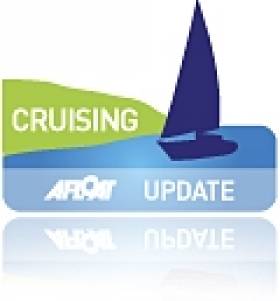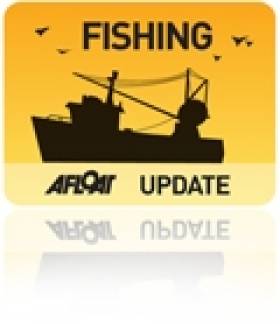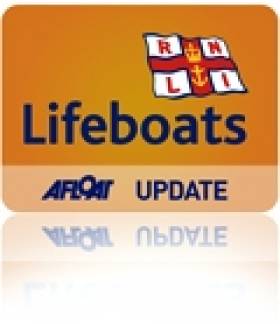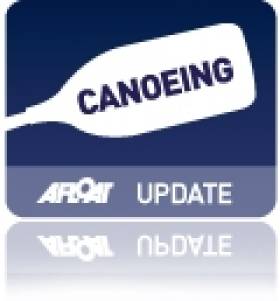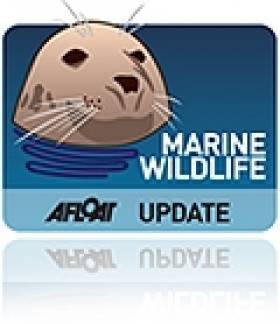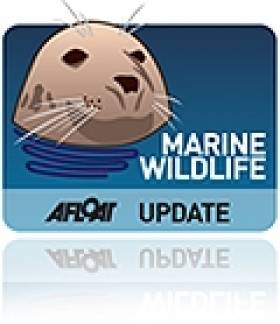Displaying items by tag: west cork
Old Gaffers Plan West Cork Cruise Along The Fastnet Coast
#westcork – The Irish President of the Old Gaffers Association is organising a sailing cruise along the West Cork coast in July with venues to include well known harbours and landmarks along the 'Fastnet coast' such as Skellig Michael via Baltimore, Schull, Crookhaven, Castletownbere, and Adrigole.
In setting out plans for the cruise in company, an upbeat OGA chief Sean Walsh says West Cork caters for inclement weather by providing some of the 'best havens in the world', where 'enjoying creamy pints on a tall stool can be taken to a higher plane altogether, where good food, great craic and music abound'.
In issuing the invitation on the OGA website Walsh says, 'Where a Summer Cruise in Company (CIC) is concerned, guaranteeing anything can be a risky business. However, I feel reasonably safe in saying that participants in our OGA CIC, West Cork, will enjoy a warm Irish welcome, a myriad of stunningly beautiful and safe anchorages and havens, to match any in the world'.
The famous coastline featured recently on Afloat.ie when WM Nixon described the wonders of boating along the West Cork Coast.
The OGA Cruise in Company, West Cork is to muster in Kinsale on 17 July 2015. The next morning the OGA fleet sails to join the Classic Fleet in Glandore, for a week of racing, cruising and shoreside festivities. On 24 July, the fleet will head west again.
West Cork Fishing Village is Youtube Hit With Chapin Carpenter's 'Come Darkness, Come Light'
#fishing – A small fishing community in West Cork is hitting the video headlines this week following the intervention of a five times US Grammy Award winner about a song of hers they recorded to raise money for a local charity writes Tom MacSweeney.
The children of Lisheen National School, led by their teacher Niamh McCarthy, near Skibbereen in West Cork, recorded a CD to raise funds for the local transport scheme taking cancer patients to Cork for treatment. They appeared on RTE Nationwide, this week, after which a viewer and a fan of the renowned American singer/songwriter Mary Chapin Carpenter, sent a note to her that the children had recorded her song 'Come Darkness, Come Light' for their Christmas CD and a video to go along with it, which is on YouTube.
Mary Chapin Carpenter looked it up sent out a Tweet and re-tweeted a link to the video, with the message: 'Best early xmas gift...children of Lisheen Nat'l School (West Cork) performing Come Darkness, Come Light."
Mary Chapin Carpenter is a five-time winner of Grammy Awards and was inducted into the Nashville Songwriters Hall of Fame in 2012.
The teacher, Niamh McCarthy, said: "Imagine, she is a five-times Grammy Award winner and she liked what the children in Lisheen, a school in West Cork, what our kids did. It is unreal the reaction. The video has gone viral as a result. It is worth going onto her Facebook page to read the comments from her fans about our children! Unreal. Our video is gone viral and we have had CD sales to the States as a result. Just posted to Alaska and Minnesota this morning!
The pupils recorded the CD of Christmas Carols to raise money for the community's Cancer Connect charity which is a local transport scheme taking cancer patients to Cork for treatment. The video tells the story of the day of the CD recording in the local church.
Body Of Fisherman Recovered Off Beara Peninsula
#Fishing - The Irish Times reports that the body of a fisherman was recovered off the Beara Peninsula in West Cork yesterday (Thursday 11 December).
Attempts were made to resuscitate the man, thought to be in his early 60s, but he was pronounced dead at the scene at Dinish Pier in Castletownbere.
The incident occurred shortly before the Baltimore lifeboat was called to aid a fisherman overcome by fumes elsewhere in West Cork, as reported this morning on Afloat.ie.
Union Hall Lifeboat Answers First Callout
#RNLI - Last Thursday 13 November, Union Hall RNLI in West Cork responded to its first callout since becoming operational.
The volunteer lifeboat crew Anthony Walsh, Lee Miles and Tim Forde launched their B Class Atlantic 75 lifeboat, Maritime Nation, at 12.03pm to aid two small leisure craft drifting aground at Mill Cove in Rosscarbery.
No persons were found on board and the crew returned to the RNLI station shortly before lunchtime. Weather conditions were poor, with Force 4-5 winds and a south-easterly swell.
The callout marked the voluntary crew’s first emergency response since the lifeboat station became operational in Union Hall two months ago.
“I’m very happy with the response time and performance of the lifeboat crew and the shore crew," said lifeboat operations manager John Kelleher. "They have been training consistently every week, it’s a big commitment and we are glad to see that has paid off on our first call out."
Meanwhile, fundraising for the lifeboat continues with a weekly series of three Friday night table quizzes taking place in Union Hall, with the first tomorrow 21 November. A painting of the lifeboat by local artist Avril McDermott will be raffled at Dinty's Bar on the final quiz night on 5 December.
The fundraising branch has stocked local shops with RNLI Christmas cards and extend their thanks to Myross Rowing Club for a recent donation of €2,500, raised by members who competed in two charity rowing events.
New Kayak & Canoe Trail Planned For West Cork
#Kayaking - West Cork is getting a new kayaking and canoeing trail to encourage adventure tourism in the region, as the Irish Examiner reports.
The new paddling trail will run between Skibbereen and Baltimore along the River Ilen and will have the full funding support of Cork County Council for works that include the upgrade of Deelish Pier in Skibbereen.
“Market research shows that people are really interested in activity-based holidays. This will be a great boost to Skibbereen and Roaringwater Bay,” said Cllr Christopher O’Sullivan at a meeting of the West Cork Municipal District in Clonakilty last month.
The Irish Examiner has more on the story HERE.
Boating Visitors To Ireland's South Coast Get Mixed Welcome Messages
#marinetourism – Ireland's south coast provides an almost infinite variety of harbours, natural havens, and extensive areas of interesting sailing water. These cater for boat enthusiasts of all kinds, with craft of every type. So how does the welcome for visitors shape up? W M Nixon contrasts the different hospitality styles of four attractive ports.
The word on the grapevine that the Ballydehob Old Boat festival had taken place arrived with an intriguing photo from Anthony O'Leary. It had been noted in the interview with him immediately after he had led the team in Ireland's Commodore Cup Victory, that while he was trying to unwind for a while, it's not really in the O'Leary makeup to relax, and soon his mind was busy with new ideas of nautical interest.
Nevertheless he was cruising gently in early August down towards West Cork in the family's handsome big Nelson powercruiser Irish Mist, a fast and able vessel which his father Archie and mates like Mick Ahern once took right round Ireland in a settled springtime spell of weather, just to be in Dublin to watch Cork Con play rugby in some major championship at Lansdowne Road.
As it turned out, this year Irish Mist was getting down west ultimately to be in Baltimore for the 1720 Nationals in late August, which O'Leary duly won. But from time to time, he flashed back some photos of interesting boats met along the way, and one which really rang the bell was a little Ette Class clinker-built gunter-rigged sloop sailing in Castlehaven.
The Ette class originated way way back, when two keen dinghy cruising types sailed their little dinghy into Castlehaven, and the Castletownshend locals in the South Cork Sailing Club were so taken by the boat that they commissioned the waterfront boatbuilders, the O'Mahony brothers, to build some sister ships as the basis of a class.
All the new boats' names ended in "ette". And the class survived for many years, though at times the Ettes were hanging on by a thread. But recently it has had a fresh lease of life with new examples of what is now a classic dinghy being built by Lui Ferreira of Ballydehob, who last came through this parish when, in 2012, he put the first teak deck on a vintage Howth 17, the syndicate-owned Deilginis.
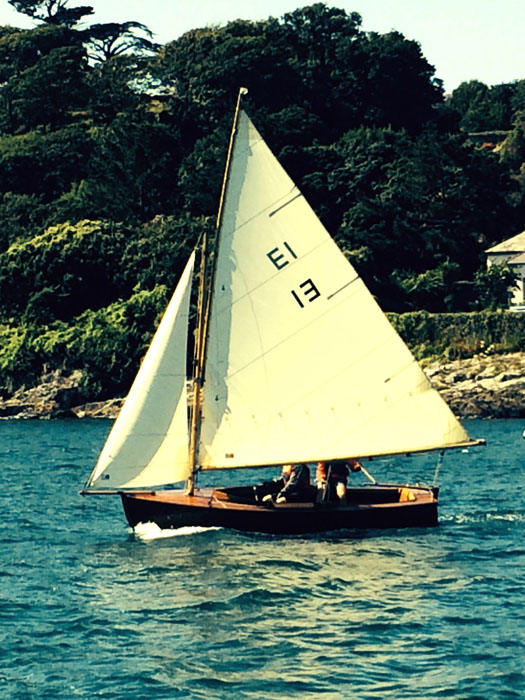
Perfection of summer – an Ette class in her home waters of Castlehaven. Photo: Anthony O'Leary
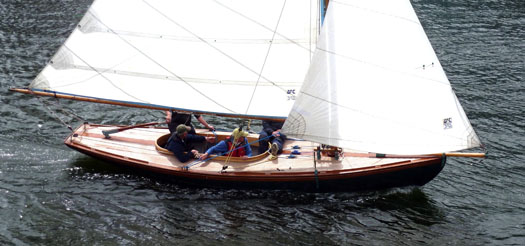 Rui Ferreira, builder in Ballydehob of the Ette Class, also put this teak deck on the 107-year-old Howth 17 Deilginis in 2012. Photo: W M Nixon
Rui Ferreira, builder in Ballydehob of the Ette Class, also put this teak deck on the 107-year-old Howth 17 Deilginis in 2012. Photo: W M Nixon
A Howth 17 looks well no matter how you photo her. But an Ette is a quirky little thing which can sometimes look odd from the wrong angle. Yet in a flash of inspiration, the Captain of the Commodore's Cup team took up his iPhone as an Ette came bustling down Castlehaven on fine sunny morning, and we got what I reckon to be one of the best photos of an Ette under way ever obtained – plus it gets the very essence of summer in Castlehaven.
The next O'Leary snap some days later was just briefly titled: "The Ballydehob Old Boat Festival, Irish Mist in archway second left". What was going on here? We'd heard vague stories about a very relaxed assembling of boat at high water at the drying quay at Ballydehob, but the O'Leary photo hinted at serious numbers and a high level of organization.

The teaser photo – first intimations of this year's Ballydehob Gathering of the Boats, with the O'Leary family's motor-cruiser Irish Mist (framed in the second arch from left) joining an eclectic group of 74 boats for a couple of hours at top of the tide. Photo; Anthony O'Leary
 This is most people's image of Ballydehob, crowded and very rural, with Mount Gabriel beyond. Only the more observant will notice the tidal river in the foreground. Photo: W M Nixon
This is most people's image of Ballydehob, crowded and very rural, with Mount Gabriel beyond. Only the more observant will notice the tidal river in the foreground. Photo: W M Nixon
To begin with, most casual visitors would scarcely think of Ballydehob as a seaport at all. Rather, it's the very essence of rural West Cork, a crowded little village where "laid-back" is the default mode, and it has been so for some time. It reached something of an apotheosis when Annie Barry (she's one of the Fergusons of Gubbeen Cheese) was running her wonderful Annie's restaurant on one side of the winding main street, and the Levis sisters Julia and Nell, feisty little ladies of mature years, were running Levis's pub across the way.
Julia and Nan were splendid folk of considerable standing, and it's said the pair of them were once squired to the West Cork Hunt Ball in Skibbereen by Jeremy Irons of Kilcoe Castle a few miles along the coast. As for the setup in Ballydehob, space was so limited in the restaurant that, having checked out your booking, you simply took up station in leisurely style across the street in the pub with Annie's menus and an aperitif or two, then Annie would come across the road and discuss your order, and a delightful evening would continue late into the night.
Alas, for some year now Annie's has been closed, though everyone lives in hope of somebody re-opening it. And in the pub, the old ladies have passed on. But now it's run by a great-nephew, and very successfully too. We got ourselves in there late on a velvet July evening this year to find the place was heaving with youth and beauty and high fashion in casual style - achingly trendy it has become.
It could have been a traditional local in any of the world's fashionable holiday areas except for one thing. A ball of fur, a terrier of some kind, emerged from among people's legs and barked its head off at me. I assumed it was because I carried a whiff of our own little Jack Russell. But the blushing girl owner told me with a big smile that her little dog must have thought I was a priest. Only along Ireland's south coast, near some former or still surviving Protestant enclave, would you have heard that particular excuse.
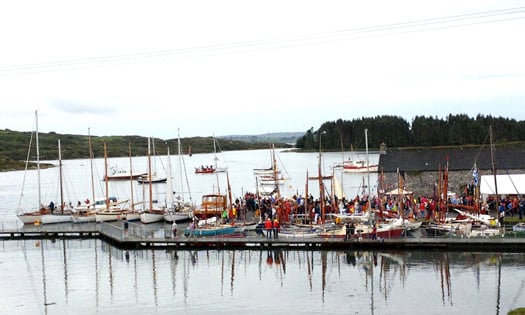 The old dock at Ballydehob is well able to receive a very varied fleet, seen here from the old railway viaduct Photo: Miriam Jones
The old dock at Ballydehob is well able to receive a very varied fleet, seen here from the old railway viaduct Photo: Miriam Jones
Just along the river from these scenes of hospitality and minor mayhem, immediately below the mighty railway viaduct which seems to be so disproportionate for the long-gone needs of the little West Cork Railway, there's Ballydehob Harbour. Time was when it was key to the place's economy, and it was in the late 1930s, only a year or so before World War II, that the Brooklands, the last surviving sail-only coasting schooner to deliver cargoes to West Cork, made her way up the winding estuary at the head of Roaringwater Bay (it's named for the Roaringwater River, much of the bay behind Carbery's Hundred Isles is well sheltered), to anchor just off the quay, as she was too deep to berth alongside.
The Brooklands was owned and skippered by Tom Creenan of Ballinacurra in the inner northeast reaches of Cork Harbour, but it was from Birkenhead or Goole on the Mersey that she'd bring her welcome cargoes of coal, a challenging passage at the best of times. At Ballydehob, while smaller cargo-carriers could get alongside the old quay, the Brooklands discharged her cargo into the multi-functional barge-type vessel known the Sandboat.
She was used by her owners, the Levis family, for just about everything, but primarily for going out among the islands towards high water, running up on a clean beach, then laboriously shovelling sand into the hold until the tide returned and the Sandboat could be floated off and piloted back to the quay where her eventually very useful cargo would be shovelled ashore to become builders' supplies.
The Sandboat was Queen of the Fleet at Ballydehob, and she played such a central role in the Levis family's life that Old Boat Festival organiser Cormac Levis's brother calls his pub in Ballydehob the Sandboat.
As for how Cormac himelf first got the notion for the Ballydehob Gathering of the Boats, he has been a tower of strength in the Traditional Boat movement, particularly in West Cork but also throughout Ireland, for many years. And with others following his example in restoring or even building new sailing lobster boats to traditional design, he suggested that getting together at Ballydehob during the little town's time-honoured summer festival around August 15th might hit the spot. And for the first one in 2004 –making this year's the tenth anniversary - they assembled nine boats, which was considered pretty good going.
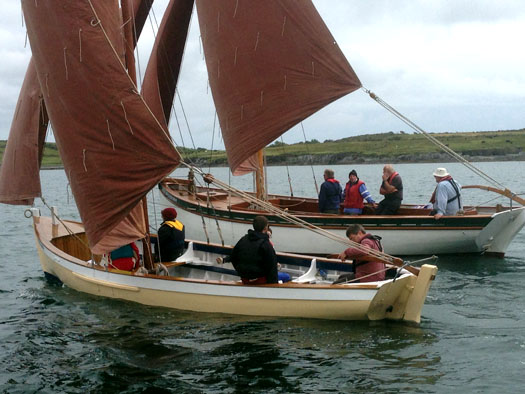
Close-up on Cormac Levis's lobster boat, which led the way for the first gathering of traditional craft at Ballydehob in 2004. Photo: Brian Marten
From it, they learnt that, for the future, while the aspiration would of course be for quiet and easy-going organization under a light hand, underneath it all there'd have to be efficiency, always with an eye on the clock. Although the tidal window is more than two hours for most boats, they've successfully accommodated modern yachts up to two metres draft without anyone being left behind stuck on the mud. But with limited manoeuvring space in both the harbour area and the channel, once the witching hour of high water is upon the fleet, it's time to start thinking about an orderly departure after two solid hours and more of good crack, mighty barbecues, and much interest in an examination of other people's traditional and classic boats.

Even among the sister-ships of the lobster fleet, many individual variants in hull lines and rig are apparent. Photo: Brian Marten

Just to add to the variety and colour, the Ilen Trust from Limerick brought their much-travelled Shannon Gandelows (right) to Ballydehob. Their stylish pennants are a legacy of heir successful visit to Venice at the end of April this year. Photo: Gary MacMahon
So the crucial thing is to select the ideal Saturday nearest to August 15th with a good big tide in mid-afternoon. As the Boat Gathering is such a force in its own right, they can range quite extensively on either side of August 15th, and to date the earliest has been August 8th, while the latest was August 21st.
This year's was Saturday August 9th, and while there may have been rain later in the day despite West Cork having much more sunshine in August than almost any other part of the country, no-body now remembers the rain as they recall the sheer fun and sense of community of what has been described by Tiernan Roe, another of the quality boat-builders of Ballydehob, as the "shortest bestest Boat Festival in the World".

Yet another creation of the active Ballydehob boat-building scene. This is an attractive little Cape Henry 21 cutter lunched in June by Tiernan Roe of Roe Boats. Photo: Tiernan Roe
For this year, it attracted 75 boats, though admittedly last year's record entry of 50 boats was greatly enhanced by this year's decision by the Drascome Lugger Association to combine Ballydehob in their 2014 cruise-in-company in West Cork, thereby adding 27 boats at a stroke.
But even with 27 boats of one class, the variety across the fleet as a whole was remarkable. So how do they assemble such a disparate fleet of boats with obviously highly-individual skippers, in such a quietly efficient way? For you'll never see or hear the Ballydehob Gathering of the Boats being publicly advertised all that much beforehand.
The method is perfectly simple. Everyone with an interest will know it is likely to be coming up on the agenda. So a month and more beforehand, Cormac will text them with the final date on a need-to-know basis. It works, and it sets the tone of quiet consideration for others and their boats in a very special festival in which some quiet sponsorship by CH Marine and West Cork-based German traditional boat fan Thomas Drewes sees that all participants get mementoes including cherished T-shirts (definitely not for general release), while barbecue facilities keep the good humour buzzing until everyone departs in style for their anchorage for the night, for although most boats hope to be berthed in Ballydehob on the big day more two hours hours before high water, once the ebb has started the channel has become much less forgiving about any pilotage errors.
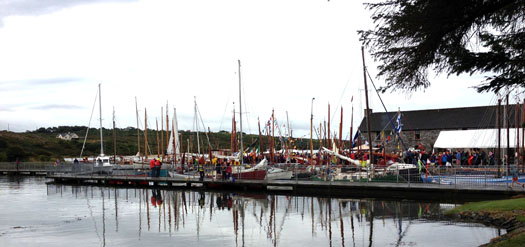
They're all here, as neatly berthed as you could please, but getting them away as the ebb starts requires good seamanship and boat-handling skills. Photo: Miriam Jones
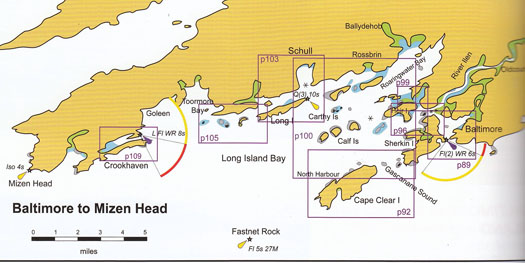
Ballydehob's central position in a hugely varied and welcoming crusing coast is emphasized by the number of other harbour chartlets indicated in this plan of the prime cruising area of West Cork. Plan Courtesy Irish Cruising Club
It's good to see a locally-focussed event like this now coming of age with a very healthy turnout. Eastward along the south coast, last weekend saw another event which will surely grow in stature and numbers, the second staging of Y2V Cruise-in-Company on the River Blackwater up the estuary from East Cork to West Waterford, as a flotilla of ten boats - eight GP14s, a Mermaid and a Feva – sailed up-river from Youghal to Villierstown.
It has been promoted by Youghal schoolboy GP 14 skipper Adrian Lee, and last year the inaugural tiny flotilla managed most of the sailable river by going to the bridge at Cappoquin before returning downriver to Villierstown. This year it achieved deserved support from the GP 14 class, with the furthest road-trailed from sea level being incoming Irish GP 14 Association President Stephen Boyle from Sutton DC, while the furthest-travelled in terms of elevation above sea level were the Blessington group, who came down from the Wicklow Hills with their Geeps and included Richard Street and kids (see again this blog on 26th July), and a brand new Duffin boat belonging to Simon Culley and Libby Tierney.
As for seniority, the classic of the class was a 60-year-old beautifully-restored Bell Woodworking GP 14 owned and skippered by 16-year-old Jack Nolan, another of that group of Youghal youngsters who are taking local dinghy sailing forward with gusto, while further variety was provided by Norman Lee of Greystones, his crew including the inevitable family pooches which are such a part of the GP 14 scene.
The sailing was mixed – as Norman said, in a river the wind will always be ahead some time, and though we think of the secret Blackwater Estuary as being fairly straight, in fact there are some quite significant curves. It took about four-and-a-half hours to sail up, and a brisker four hours to return on Sunday morning's ebb.
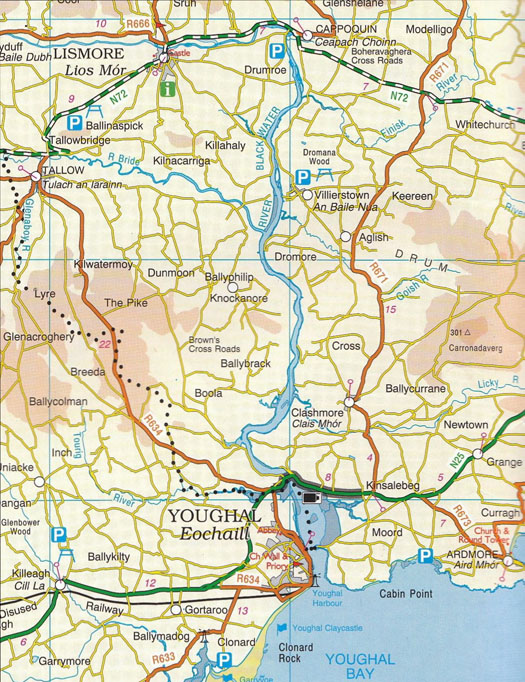
The secret waterway – the Blackwater Estuary from Youghal up to Cappoquin and almost to Lismore is one of Ireland's least-sailed rivers

Villierstown's new clubhouse, open only three weeks, was ready and willing to make welcome the crews who had sailed up from Youghal. Photo: Norman Lee

The new facility, Villierstown's "floating pier"
(right), was originally the in-harbour pontoon at Dungarvan SC. Photo: Norman Lee
At Villierstown, the new clubhouse of the Villierstown Boating & Activites Cub had been open only three short weeks, but they've made good use of a sports council grant, and it well fulfills a multi-purpose role, including providing the hospitality needed by sailing campers, with Paul Virtue and his wife Caroline organising a fine feast in the clubhouse on the Saturday night, and an enormous breakfast on Sunday to send them on their way downriver to round out an event which has future annual success written all over it.
One of the reasons it all went so well was that the slightly cogglesome little plastic floating jetty, along which the sailors of Villierstown used to access their small boats, has been replaced by a proper pontoon which the club acquired when Dungarvan SC eastward along the coast up-graded their in-harbour pontoon. In fact, Dungarvan support for the development of Blackwater sailing didn't stop there, as one of the fleet in the Y2V was a vintage Dungarvan-based Mermaid in which owner Eugene Burke has cruised the entire south coast between Ballycotton and Kilmore Quay.
The boat is Akita, Mermaid No. 85, and she has certainly been around, as she was built in the Barkyard in Skerries in 1953 by Joe and Matt Boylan. The Barkyard was originally the place where the Skerries-based coasting schooners and fishing boats had their sails preserved against rot by tanning with bark, but in the 1950s the now redundant premises were used to build some of the eventually enormous fleet of Skerries Mermaids through a boat-building class run by the colourful Jem Kearney.
The Fingal region around Skerries and Rush continues to be the great heartland of the Mermaids, with some very racy boats built in the old mill at Rogerstown recently, but despite the modern challenge, this year's Mermaid Week at Rush saw the champion emerge in the form of Jonathan O'Rourke of the National YC with his vintage boat, one of the few Mermaid sailors still in Dun Laoghaire.

The welcoming port. Despite its tidal limitations, Dungarvan lays on the welcome in a big way. This shows a visiting fleet at the original pontoon, which has now been moved to Villierstown. Photo Kevin Dwyer, courtesy Irish Cruising Club
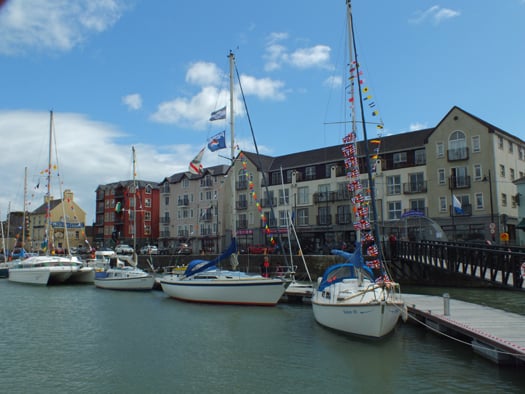
Dungarvan SC's new in-harbour pontoon has much improved the alongside berthing space, but unfortunately the local Council wouldn't permit dredging to improve access.......Photo: Donal Walsh

....and thus the reality for most boats in the Inner Harbour is a drying berth.......... Photo: W M Nixon
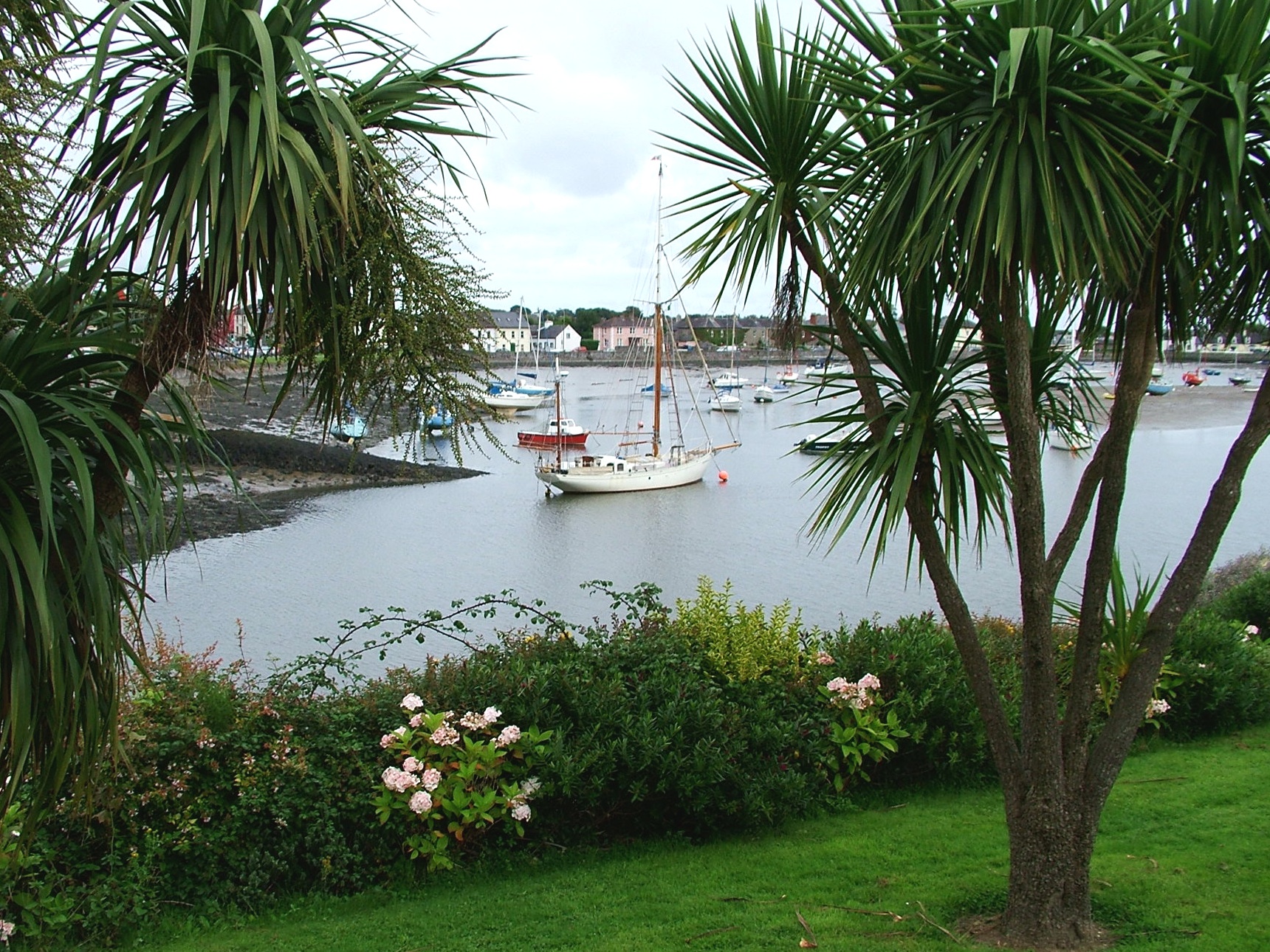
....but if you've access to local knowledge, there is a deep pool just below the bridge........Photo: Donal Walsh
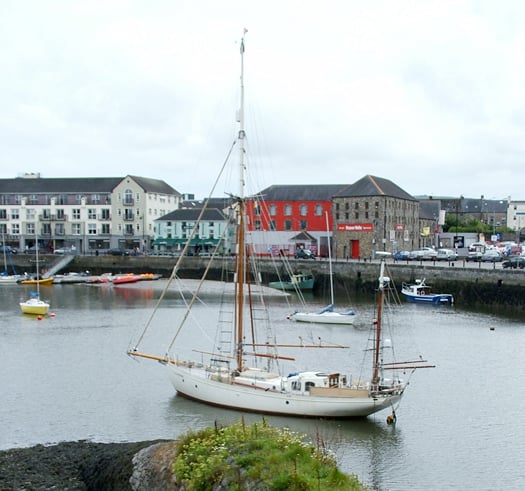
.....and here the Northwest Passage transiting 44ft steel gaff yawl Young Larry is visiting in comfort and style. Photo: Donal Walsh
Meanwhile in Dungarvan the club's hopes of doing a bit of dredging to improve access to their extended in-harbour pontoon was stymied when the council said they wouldn't permit any salt-contaminated sludge being brought up onto the quay. But despite its tidl limitations, it's a hugely hospitable place, and if you do take the ground at the pontoon, it's mostly soft and forgiving mud which enables you to sit in relative comfort. Certainly some very substantial cruising boat have overnighted here to enjoy the fine pubs both on the waterfront waterfront and in the town, while culinary standards are set by Paul Flynn's famous restaurant The Tannery just round the corner.
Nevertheless if you absolutely won't let your boat dry out, leading Dungarvan cruising man Donal Walsh (he has just returned from an epic round Ireland and Britain clockwise cruise with his Moody 31 Lady Kate) well knows the deep pool across the harbour close under the bridge, and he saw to it that his brother-in-law Andrew Wilkes and sister Maire Breathnaith found a secure berth there for their hefty 44ft steel-built gaff yawl Young Larry, a boat in which they transited the Northwest Passage, but she looks well at home in Dungarvan with its fine tradition of first class locally-based trading schooners.
In moving along the south coast, we find that when possible, they'll lay out the welcome mat big-time in Ballydehob, Youghal, Villierstown and Dungarvan, despite the fact that all four places are restricted in what they can do by the exigencies of tide.
So how are things working out in Dunmore East, the one port which has the potential to be one of the most welcoming and accessible all-tide sailing and fishing ports along the entire south coast?
Despite this potential, the under-development of its facilities, fuelled by a sometimes poisonous attitude between fishermen and other harbour users, has provided recreational visitors with often unpleasant memories. In trying to understand why this might be so, we have to understand how Dunmore East came to get its pretty little harbour. When it was built in the first half of the 19th Century, it was not – as is commonly supposed – built for the benefit of fishermen. The horrible fact is that fishermen came so far down the pecking order that they just had to make do for themselves as best they could.
The handsome new pier at Dunmore East, designed by Alexander Nimmo who is best known for developing Tobermory in Scotland and many places in Galway including Roundstone, was constructed exclusively for the use of the new fast sailing cross-channel packet boats serving the top people of Waterford in their trading and communication with Britain, while the unfortunate local fishermen were forced to keep their boats in the limited shelter of The Cove to the north of it, and haul them on the exposed beaches at The Strand and Councillors Strand.
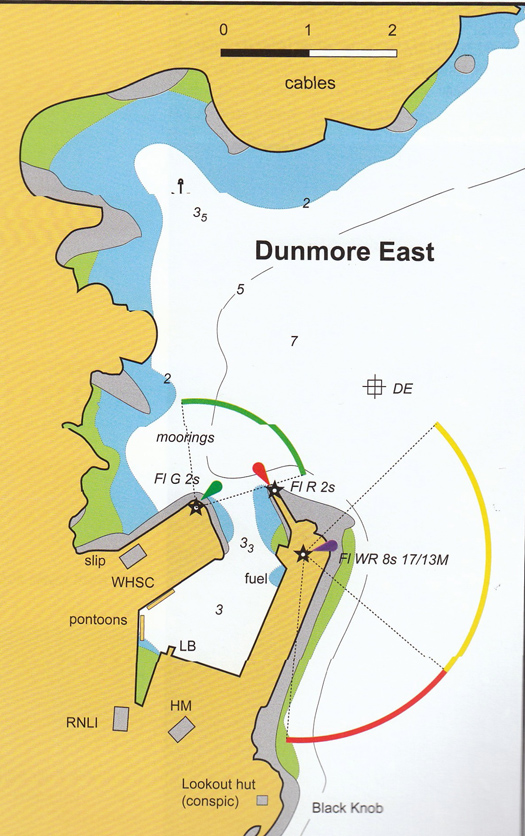
Dunmore East's substantial pier was new-built originally to provide a port for cross-channel sailing Packet Boats, serving Waterford ten miles up the road. When this was its primary function, any local fishermen were banished to the poorly-sheltered coves to the north, with their boats being hauled up on the exposed beaches beyond. Plan courtesy Irish Cruising Club
Soon, however, steam driven packet boats were able to go conveniently all the way up to Waterford, and Dunmore East was redundant as a packet-boat harbour. But it was only with reluctance that fishing boat were allowed to start using it, as the Royal Navy would have been keeping an eye on its possibilities for their own occasional use.
Yet down the years, the idea has developed that Dunmore East was always primarily a fishing harbour, and to a lesser extent the same attitude prevailed at Howth on the east coast, where the new harbour functioned as the Packet Boat station for Dublin only between 1817 and 1826, when the developing new asylum harbour at Dun Laoghaire became the selected port for the Royal Mail's new paddle steamers serving the cross-channel route. Yet the silted harbour at Howth was only allowed to become a "fishing station" in the 1850s.
The legacy of all this, in Dunmore East at any rate, is that there still seems to be a suspicion among the fishing community that their tenure is only temporary, that the powers-that-be would move them out if they see a better use for the place. How else can we explain the negative and almost paranoid attitude of the fishing spokesmen every time a suggestion for a much-needed marina at Dunmore East is put forward?
With all this in mind, I made a quick visit to Dunmore East in mid-August while on other business in the southeast, in the hope of seeing if a much-trumpeted €4 million dredging scheme was now in progress in the harbour, and also to see how an equally celebrated new Visitors Pontoon along the East Pier was working out.
The photos speak for themselves. There wasn't any sign of a dredger, though doubtless that will turn up in due course. Yet as for the 40 metre pontoon, it's not a leisure-boat-friendly neat little piece of work at all, but is quite a massive and brutal steel box structure more suited to rugged fishing boats, who were showing their approval by using it so totally that the only leisure visitor was a German motor-cruiser which had managed to squeeze in at one end.
But as this pontoon is on the wrong side of the harbour for ease of access to the Sailing Club on the west side, and the welcoming facilities in the village above it, any pedestrian boat visitor – the vast majority of incoming leisure boaters, in other words – has a long trek through the sometimes crowded and malodourous delights of a fishing port before they can access any amenities. So not surprisingly the German boat had its inflatable tender moored outside it for quick and easy movement across the harbour, and along to the beaches if wished, a situation which inevitably precluded any other newly-arrived boat from rafting up alongside
So for any cruising boat coming in from sea, often with the challenge of Hook Head just recently put astern, it wasn't a welcoming setup. In fact, it was downright hostile. While we were there, an ordinary sailing cruiser with happy folk aboard came motoring from the eastward to round the end of the pier after stowing their sails, but their hopes of a convenient and enjoyable visit to Dunmore East were soon dashed. No welcoming RIB came out from the sailing club to direct them to a vacant mooring, as there probably wasn't one. And as for the pontoon, "unwelcoming" is inadequate. It clearly didn't want anything to do with them. You could see their spirits wilting as they headed out, faced with the long haul up to the marina in Waterford City. The current visitor berthing situation in Dunmore East is at the very least a sad business, so where does it go from here?

Dunmore East in mid-August. No sign of any dredging, and the "Visitors Pontoon" under the lighthouse on the East Pier is packed out with fishing boats.......Photo: W M Nixon
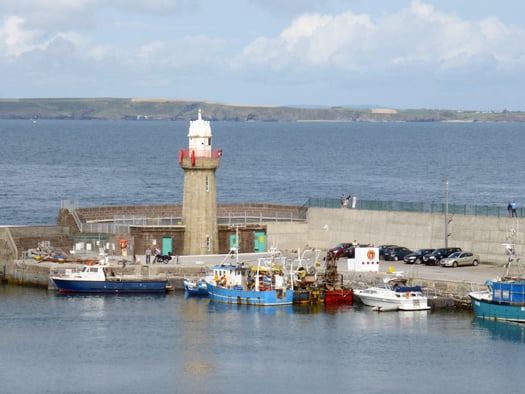
........and just one visiting German motor cruiser which was protected against any rafting up by its tender on the outer side. Photo: W M Nixon

The new pontoon is an industrial standard piece of kit......Photo: W M Nixon
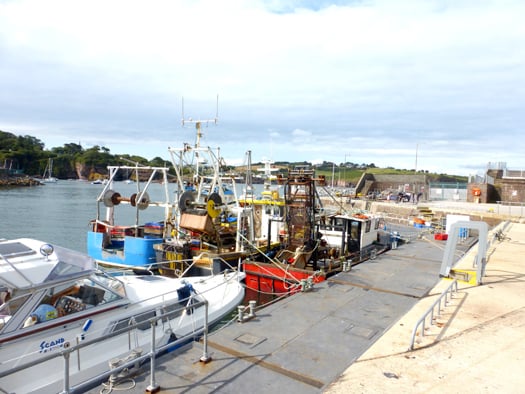
....and understandably very popular with active fishing boats. Photo: W M Nixon

But for visiting sailing boats newly arrived in port.......Photo: W M Nixon
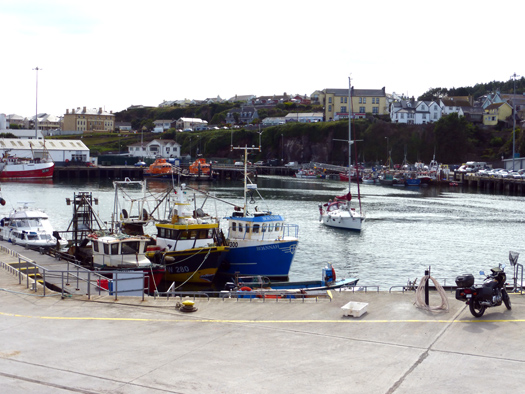
....it's soon clear that there isn't really a welcoming berth for them.....Photo: W M Nixon
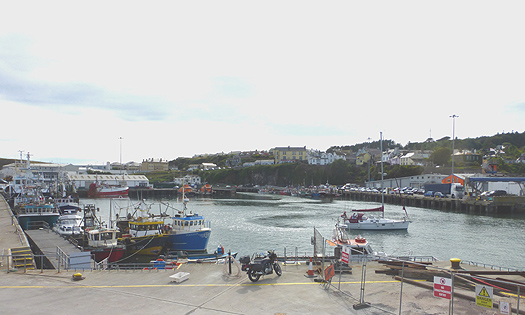
....and they head out to sea again, visibly disappointed by their Dunmore East welcome. Photo: W M Nixon
Dolphin Killed By Plastic Beer Can Ring
#MarineWildlife - A juvenile dolphin has died in West Cork after getting its beak caught in a discarded plastic ring from a multipack of beer cans, as the Irish Independent reports.
Locals were shocked to find the common dolphin in distress near Schull Harbour unable to free itself from the plastic, and after a lengthy struggle it died shortly afterwards.
Plastic rings from multipacks of beer or soft drinks cans have long been a blight for animal life as they can easily be snagged in the tight, tear resistant plastic.
Independent.ie has more on the story HERE.
#MarineWildlife - Late summer brings fin whales flocking to West Cork in big numbers, with the Irish Whale and Dolphin Group estimating at least 20 of the second-largest ocean species sighted between Seven Heads and Galley Head.
Indeed, as IWDG sightings officer Padraig Whooley writes, the gathering "is certainly the largest validated aggregation of this species so far this year" and comes some months ahead of the usual peak from October to December.
Recommended spots for watching these fin whale visitors - though you will need some decent binoculars to get the best views - are the aforementioned Galley Head and Seven Heads as eel as Cloghna Head, Dunworley and Sandscove.
Kerry has its own share of whale visitors, with a "lovely run" of humpbacks in recent weeks, while East Coast residents aren't left out, either, with a rare sighting of a minke whale in the Irish Sea some 20km off Bray Head over a week ago.
In other cetacean news, West Cork has become home to a new solitary dolphin in the form of Clet, a bottlenose who's been spotted in Glandore, Baltimore and Schull after time from Devon, Cornwall, South Wales and originally France.
Yet as IWDG welfare officer Paul Kiernan warns, Clet might appear cute but he's very much a wild animal, with reports claiming a swimmer off Sherkin Island was "aggressively pushed underwater by the dolphin".
Such stories, Kiernan writes, point "to the need for people to exercise common sense and extreme caution in how best to enjoy an interaction with this very large, apex predator."
He adds: "Bottlenose dolphins are not cute and cuddly, they are not our 'friends' and nor do they benefit in any meaningful or long term way from interacting with humans."
Entry Boost Gets Calves Week Off to a Flying Start
#calvesweek – There has been a marked increase in entries to Calves Week this year writes Claire Bateman. Entries are up 25% with boats coming to Schull from clubs around the coast for the 4 day regatta. Boats from Waterford and Kerry Sailing Clubs are joining the usual strong contingents from Kinsale, Crosshaven and Dublin, and a few new visitors from the UK completed the strong racing line up. With 15 boats competing in some classes, some great days' racing is promised in the Cork Dry Gin sponsored event.
With light winds from the south east backing south forecast for the starting day's racing, Race Officer Neil Prendeville kept the starts clean with separate guns for the four cruiser classes as well as the two Whitesail classes outside Copper Point. He chose a windward course for the fleets out around the Calf Islands. The cruisers were able to hoist their spinnakers from a laid mark south of West Calf Island with a leeward run back to the Amelia Buoy. Class 0/1 completed 3 rounds with the other classes completing fewer laps. A sailing breeze picked up, allowing the various fleets the opportunity to complete before the weather unexpectedly closed in.
With a spread of entrants from sailing clubs around the country, racing competitively against each other, winners were produced from around the country. Conor Doyle in Freya from Kinsale YC) took line honours and won Class 0/1, IRC ahead of Colman Garvey in True Penance (RCYC) and Rob McConnell in Fools Gold (Waterford Harbour SC). In Echo, Freya again took the honours, ahead of local boat Infinity with Dave Harte and Des Cummins in Dear Prudence (RStGYC). In Class 2 IRC while Dexterity from Foynes YC (McEneff/Madden/Hobbs) took line honours, on corrected time the day went to Frank Desmond, RCYC, on Bad Company ahead of Derek Dillon, Foynes YC, in Big Deal and Viking with Robert Dix/Brian McKernon (Howth YC). Big Deal took Echo honours, ahead of Val Kriss (Nigel Dann, KYC) and Bad Company.
Class 3 saw a 1:2 punch for Cobh SC, with Billy Burke and Danny McCarthy's Sigma 33, Muskateer, first over the line in Class 3 and rewarded with first in both IRC and Echo, ahead of Adrian Tyler on a Hunter Impala, Whyte Knight. Jimmy Nyhan on Outrigger (RCYC) and Padraig O Donovan on Chameleon (KYC) took third in IRC and Echo respectively.
Saoirse, under Richard Hanley from Kinsale YC won Class 4 IRC and Echo respectively, ahead of local boats Witchcraft (Simon Nelson) and Barossa (Edmund Krugel) in Echo.
In the fleet of larger whitesail boats, John Dowling in Samba (RCYC) crossing the line first and getting both IRC and Echo honours. Ger Hayes' First 36.7, Y-Dream took second in both handicaps. Dufour 425 Act 2 (Roche, O'Leary, Andrews) took third place in IRC, and new entrant Samatom, a UK based
XC45 sailed by Bob Rendell, was third in Echo. In Whitesail 2, Ashanta took IRC honours, with local boats Aoife under Hugh O'Donnell, and Giggles under Peter Morehead, first and second in Echo, ahead of Calypso, another UK based boat under John McCarthy (MBSC).
In keeping with friendly nature of the club, any newcomer to Schull has been offered a "buddy boat" – a local captain to share important details like the need for attention to the local sailing hazards and where to get a good meal after an
West Cork RIB Adrift Prompts Baltimore Lifeboat Call Out
#ribs – At 20:48 last night Baltimore's RNLI all weather lifeboat was alerted to a Rigid Inflatable Boat (RIB) adrift four miles south of Glandore in West Cork. The lifeboat proceeded to rendezvous with the two young men who had been en route from Cork to Baltimore when their engine failed.
Crew member Diarmuid Collins went aboard the RIB to establish a tow. The lifeboat then towed them to the safety of Baltimore Harbour.
On board the 'Alan Massey; lifeboat were Coxswain Kieran Collins, mechanic Brian McSweeney, Pat Collins, Diarmuid Colllins, Tadhg Collins, Jim Baker, John O'Flynn.


























